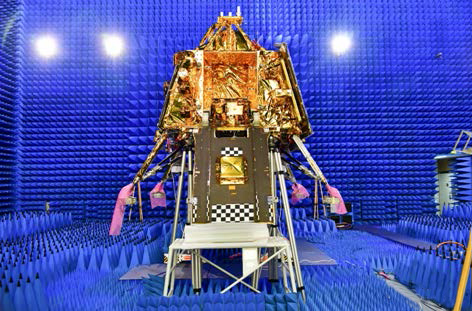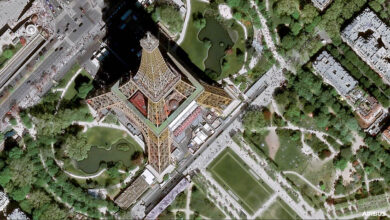Chandrayaan-3 Undergoes Key Test Successfully
Indian Space Research Organisation (ISRO) said that the ‘Chandrayaan-3’ lander has “successfully” underwent the Electro-Magnetic Interference,Electro-Magnetic Compatibility (EMI/EMC) test between January 31 and February 2 at the U R Rao Satellite Centre here.

The EMI/EMC test is conducted for satellite missions to ensure the functionality of the satellite subsystems in the space environment and their compatibility with the expected electromagnetic levels, ISRO said.
It said, this test is a major milestone in the realisation of the satellites.
According to the space agency, Chandrayaan-3 interplanetary mission has three major modules. They are – the Propulsion module, Lander module and Rover, and the mission’s complexity calls for establishing radio-frequency (RF) communication links between the modules.
“During the Chandrayaan-3 lander EMI/EC test, Launcher compatibility, Antenna Polarization of all RF systems, Standalone auto compatibility tests for orbital and powered descent mission phases, and Lander and Rover compatibility tests for post landing mission phase were ensured.
The performance of the systems was satisfactory,” it added. The Chandrayaan-3 is a follow-on mission to Chandrayaan-2 to demonstrate end-to-end capability in safe landing and roving on the lunar surface. It consists of Lander and Rover configuration, and will be launched by GSLV MK-III from Satish Dhawan Space Centre (SDSC), Sriharikota.
The propulsion module will carry the Lander and Rover configuration till 100 km lunar orbit. The propulsion module has Spectro-polarimetry of Habitable Planet Earth (SHAPE) payload to study the spectral and polarimetric measurements of Earth from the lunar orbit.
The Lander payloads has Chandra’s Surface Thermophysical Experiment (ChaSTE) to measure the thermal conductivity and temperature; Instrument for Lunar Seismic Activity (ILSA) for measuring the seismicity around the landing site; Langmuir Probe (LP) to estimate the plasma density and its variations.
A passive Laser Retro-reflector Array from NASA is accommodated for lunar laser ranging studies. The Rover payloads has Alpha Particle X-ray Spectrometer (APXS) and Laser Induced Breakdown Spectroscope (LIBS) for deriving the elemental composition in the vicinity of landing site.
In 2019, India’s maiden attempt to land a rover on Moon was unsuccessful aboard the Chandrayaan-2 mission after it crashed on the lunar surface. The Chandrayaan-3 is likely to be launched in June.
ISRO is learnt to have finalised possible landing sites for Chandrayaan-3
Meanwhile, The Indian Space Research Organisation (ISRO) has finalised the coordinates of three possible landing sites for its third lunar mission.
All the probable landing sites are on the moon’s south polar region on the side facing earth, senior scientists from the space agency said
The criteria for selecting the landing sites for Chandrayaan-3 – a follow-on mission to Chandrayaan-2 which is meant to demonstrate end-to-end capability in safe landing and roving on the lunar surface – included local and global slope, illumination from the sun, radio communication with earth, and crater and boulder sizes, a space scientist said.
The moon’s southern polar region is of particular interest to scientists because there’s a possibility of finding water ice. Chandrayaan-3, expected to be launched later this year, will have a lander and a rover.
The Chandrayaan program, also known as the Indian lunar exploration programme, is an ongoing series of outer space mission by ISRO. The first moon rocket, Chandrayaan-1, was launched in 2008, and was successfully inserted into the lunar orbit.
Chandrayaan-2 was successfully launched and inserted into lunar orbit in 2019, but its lander crash-landed on the moon’s surface when it deviated from its trajectory while attempting to land on September 6, 2019, due to a software glitch.
The prime landing site for Chandrayaan-3 lies between Manzius U and Boguslawsky M craters on the moon. It also provides flexibility for the lander to land at any place in the 4km x 2.4km area within a distance of 100m from the lander hovering point, according to ISRO.
To select suitable sites using coarse and medium resolution data, the local slope should be less than 10 degrees, the global slope should tend towards the equator, more than 90% of the site area should be sunlit for 10-11 days, boulder size should not be more than 2m, and there should be minimum crater and boulder distribution in the area, said a scientist from ISRO’s Space Application Centre, who is associated with the mission.
“The site selection started with the analysis of the three shortlisted sites for Chandrayaan-2 landing in the 70-80 degrees latitude range,” he said, seeking anonymity. “These sites were revisited again for Chandrayaan-3 landing sites, but it was found that these sites are not meeting the landing area (4km x 2.4km) requirement.”
Chandrayaan-3 consists of an indigenous lander module, a propulsion module, and a rover. Its objectives include developing and demonstrating new technologies required for interplanetary missions. The lander will have the capability to soft land at a specified lunar site and deploy the rover, which will carry out in-situ chemical analysis of the lunar surface during the course of its mobility.
The lander and the rover will have scientific payloads to carry out experiments on the lunar surface.
Chandrayaan-3 will be launched by Launch Vehicle Mark-3 (LVM-3) rocket from Satish Dhawan Space Centre, Sriharikota. The propulsion module will carry the lander and rover configuration till 100km lunar orbit.
The aim of the mission is to demonstrate safe and soft landing on the lunar surface, and have the rover moving around on the lunar surface to conduct in-situ scientific experiments. ISRO has three big-ticket missions lined up between the end of 2023 and the first quarter of 2024. Aditya-L1, India’s first dedicated scientific mission to study the sun, and Gaganyaan’s uncrewed ‘G1’ mission is targeted to be launched in the last quarter of 2023. This would be followed by the second uncrewed ‘G2’ mission in the second quarter of 2024, before the final human space flight ‘H1’ mission in the fourth quarter of 2024.





